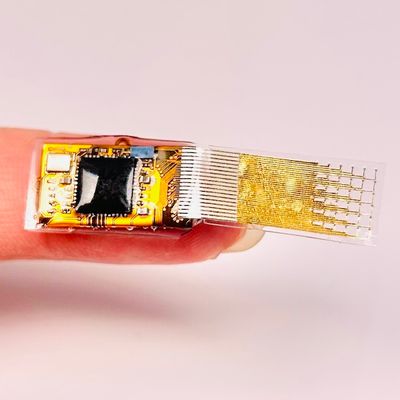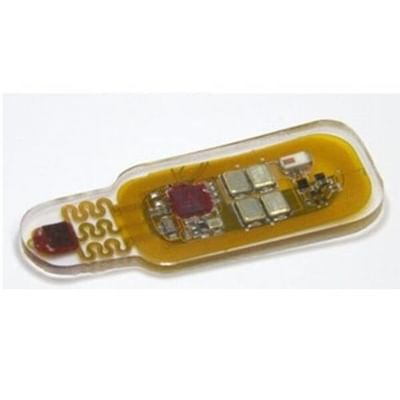- Undergraduate
Bachelor's Degrees
Bachelor of ArtsBachelor of EngineeringDual-Degree ProgramUndergraduate AdmissionsUndergraduate Experience
- Graduate
Graduate Experience
- Research
- Entrepreneurship
- Community
- About
-
Search
Overview
Professor Ouyang develops bio-integrated microsystems to advance precision healthcare as well as fundamental brain research. His work spans wearables and implantable biosensors for continuous molecular monitoring of health to neural probes for spatiotemporal mapping of neural electrophysiology and neurochemical dynamics. Before joining Dartmouth, he was a postdoctoral fellow with Professor John Rogers at the Querrey Simpson Institute for Bioelectronics at Northwestern University. He received his BS in microelectronics from Peking University and both his SM in electrical engineering and computer science and his PhD in electrical engineering from the Massachusetts Institute of Technology (MIT), where he trained under Professor Jongyoon Han.
Research Interests
Bioelectronics; biosensors; wearables; implantables; MEMS; microfluidics; neuroengineering
Education
- BS, Microelectronics, Peking University 2013
- SM, Electrical Engineering and Computer Science, MIT 2016
- PhD, Electrical Engineering, MIT 2019
Awards
- Maximizing Investigators' Research Award, NIH/NIGMS, 2025
- Chinese Government Award for Outstanding Self-financed Students Abroad, 2020
- Dimitris N. Chorafas Foundation Prize for Excellence in Scientific Research , 2020
- The Helen Carr Peake and William T. Peake Research Prize, MIT, 2018
- Ernst A. Guillemin Thesis Award for Best Master’s Thesis in Electrical Engineering, MIT, 2016
- Siebel Scholar, Class of 2016
- CBMS Travel Grant, the Chemical and Biological Microsystems Society, 2013
- Distinguished Graduate Award, Peking University, 2013
- Best Undergraduate Thesis Award, Peking University, 2013
- Best Undergraduate Research Award, Peking University, 2013
- National Innovation Fellowship for Undergraduate Research, Ministry of Education, China, 2012
- National Embedded System Design Contest, Third Prize, Ministry of Industry and Information, China, 2012
- Dean’s Scholarship for Academic Excellence, Peking University, 2009–2013
- National Undergraduate Physics Olympiad Competition, First Prize, Beijing Physics Society, 2011
Professional Activities
- NIH Early-Career Reviewer (ECR) Program
- Scientific Journal Reviewer: Science, Nature Biomedical Engineering, Nature Communications, Science Advances, Advanced Materials, Biosensors & Bioelectronics, ACS Sensors, International Journal of Extreme Manufacturing, Advanced NanoBiomed Research, Complex & Intelligent Systems, Micromachines, Sensors, Biosensors, Digital Signal Processing, Sensors & Actuators B: Chemical, Biomedical Microdevices, Measurement Science and Technology
- Editorial Board Member: Micromachines, Applied Nano, Frontiers in Bioengineering and Biotechnology
Research Projects
-
Neural interfaces
Neural interfaces
We develop devices that enable multimodal, spatiotemporally resolved recording of neuroelectrophysiology and neurochemical dynamics, synchronized with peripheral physiology and behavioral output in freely behaving animals, providing powerful tools for advancing our understanding of the brain.
-
Bioelectronics for precision healthcare
Bioelectronics for precision healthcare
We develop wearable and implantable devices for health monitoring and therapeutic intervention, leveraging diverse sensing modalities, including electrochemical, mechanoacoustic, and optoelectronic sensing, and stimulation modalities such as electrical and pharmacological delivery.
-
MEMS and micro/nanofluidic sensors
MEMS and micro/nanofluidic sensors
At the core of novel wearable and implantable devices are cutting-edge sensing technologies that can be integrated with the body. In this project, we study fluid and molecular transport phenomena at the micro- and nanoscale to develop tools for precise biomolecule manipulation, enabling lab-on-a-chip solutions for disease diagnosis.
Selected Publications
- Y. Zhang, E. Rytkin , L. Zeng , J.U. Kim , L. Tang , H. Zhang , A. Mikhailov , K. Zhao , Y. Wang , L. Ding , X. Lu , A. Lantsova , E. Aprea , G. Jiang , S. Li , S.G. Seo , T. Wang , J. Wang , J. Liu , J. Gu, F. Liu , K. Bailey , Y.F. Li , A. Burrell , A. Pfenniger , A. Ardashev , T. Yang , N. Liu , Z. Lv , N. Purwanto , Y. Ying , Y. Lu , C. Hoepfner , A. Melisova , J. Gong , J. Jeong , J. Choi , A. Hou , R. Nolander , W. Bai , S.H. Jin , Z. Ma , J. Torkelson , Y. Huang,* W. Ouyang,* R. Arora,* I. Efimov,* and J.A. Rogers,* "Millimetre-scale, bioresorbable optoelectronic systems for electrotherapy," Nature 640, 77–86 (2025).
- W. Ouyang, K.J. Kilner, R.M.P. Xavier, Y. Liu,Y. Lu, S.M. Feller, K.M. Pitts, Y. Wu, H. Luan, J. Trueb, E.M. Higbee-Dempsey, I. Stepien, N. Ghoreishi-Haack, C.R. Haney, H. Li, M. Heshmati, A.R. Banks, S.A. Golden, C.H. Good, and J.A. Rogers, "An implantable device for wireless monitoring of diverse physio-behavioral characteristics in freely behaving small animals and interacting groups," Neuron 112, 1764–1777 (2024).
- W. Ouyang,† W. Lu,† Y. Zhang,† Y. Liu, J. U. Kim, H. Shen, Y. Wu, H. Luan, K. Kilner, S. P. Lee, Y. Lu, Y. Yang, J. Wang, Y. Yu, A. Wegener, J. Moreno, Z. Xie, Y. Wu, C. Wu, W. Bai, H. Guo, T.-L. Liu, H. Bai, G. Monti, J. Zhu, S. Madhvapathy, J. Trueb, M. Stanslaski, E. Higbee-Dempsey, II. Stepien, N. Ghoreishi-Haack, C. Haney, Y. Huang, R. Ghaffari, A. Banks, T. Jhou,* C.H. Good,* and J.A. Rogers,* "A wireless and battery-less implant for multimodal closed-loop neuromodulation in small animals," Nat. Biomed. Eng. 7, 1252–1269 (2023).
- H. Jeong,† J.-Y. Yoo,† W. Ouyang,† A. L. J. X. Greane, A. J. Wiebe, I. Huang, Y. J. Lee, J. Y. Lee, J. Kim, X. Ni, S. Kim, H.L. Huynh, I. Zhong, Y.X. Chin, J. Gu, A.M. Johnson, T. Brancaccio, and J.A. Rogers,* "Closed-loop network of skin-interfaced wireless devices for quantifying vocal fatigue and providing user feedback," Proc. Natl. Acad. Sci. 120, e2219394120 (2023).
- J.-T. Kim,† W. Ouyang,† H. Hwang,† H. Jeong,† S. Kang, S. Bose, S. S. Kwak, X. Ni, H. Kim, J. Park, H. Chen, A. Soetikno, J. Kim, S. Xu, L.P. Chamorro,* J.A. Rogers,* "Dynamics of plosive consonants via imaging, computations, and soft electronics," Proc. Natl. Acad. Sci. 119, e2214164119 (2022).
- H. Guo,† W. Bai,†* W. Ouyang,† Y. Liu, C. Wu, Y. Xu, Y. Weng, H. Zang, Y. Liu, L. Jacobson, Z. Hu, H.M. Arafa, Q. Yang, D. Lu, S. Li, L. Zhang, X. Xiao, E. Dempsey, N. Ghoreishi-Haack, E.A. Waters, C.R. Haney, A.M. Westman, M.R. MacEwan, M.A. Pet,* J.A. Rogers,* "Wireless implantable optical probe for continuous monitoring of oxygen saturation in flaps and organ grafts," Nat. Commun. 13, 3009 (2022).
- X. Ni,† W. Ouyang,† H. Jeong,† J.-T. Kim, A. Tzaveils, A. Mirzazadeh, C. Wu, J. Y. Lee, M. Keller, C. K. Mummidisetty, M. Patel, N. Shawen, J. Huang, H. Chen, S. Ravi, J.-K. Chang, K.H. Lee, Y. Wu, F. Lie, Y.J. Kang, J.U. Kim, L.P. Chamorro, A.R. Banks, A. Bharat, A. Jayaraman, S. Xu,* and J.A. Rogers,* "Automated, multiparametric monitoring of respiratory biomarkers and vital signs in clinical and home settings for COVID-19 patients," Proc. Natl. Acad. Sci. 118, e2026610118 (2021).
- W. Ouyang, J. Han,* "One‐Step Nucleic Acid Purification and Noise‐Resistant Polymerase Chain Reaction by Electrokinetic Concentration for Ultralow‐Abundance Nucleic Acid Detection," Angew. Chemie. 132, 11074–11081 (2020).
- W. Ouyang, J. Han,* "Universal amplification-free molecular diagnostics by billion-fold hierarchical nanofluidic concentration," Proc. Natl. Acad. Sci. 116, 16240–16249 (2019).
- W. Ouyang, Z. Li,* J. Han,* "Pressure-modulated selective electrokinetic trapping for direct enrichment, purification, and detection of nucleic acids in human serum," Anal. Chem. 90, 11366–11375 (2018).
- W. Ouyang, X. Ye, Z. Li,* J. Han,* "Deciphering ion concentration polarization-based electrokinetic molecular concentration at the micro-nanofluidic interface: Theoretical limits and scaling laws," Nanoscale. 10, 15187–15194 (2018).
- W. Ouyang, S. H. Ko, D. Wu, A. Y. Wang, P. W. Barone, W. S. Hancock, J. Han,* "Microfluidic platform for assessment of therapeutic proteins using molecular charge modulation enhanced electrokinetic concentration assays," Anal. Chem. 88, 9669–9677 (2016).
† denotes equally contributed authors; * denotes corresponding authors
News


In the News
El Mundo America
They create a pacemaker smaller than a grain of rice, disposable, and activated by light
Apr 04, 2025
They create a pacemaker smaller than a grain of rice, disposable, and activated by light
Apr 04, 2025




